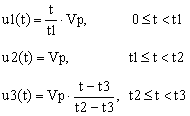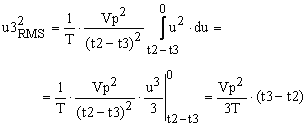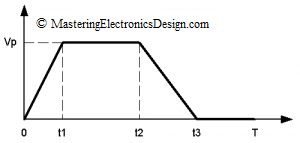In this article I will show you how to calculate the RMS value of a trapezoidal waveform. This periodic waveform is shown in Figure 1. It has a rise time from 0 to t1 and a fall time from t2 to t3. The plateau is between t1 and t2, and the signal is periodic with the period T. If you know this, then you can derive the RMS value of a triangle, square and pulse waveform as well. Go to How to Derive the RMS Value of a Triangle Waveform and How to Derive the RMS Value of Pulse and Square Waveforms for further reading.
In order to calculate the RMS value (voltage or current) of a periodic signal, let’s start with the RMS definition.
 |
(1) |
For the signal in Figure 1, we can split the waveform in 3 signals, each one with its own linear function.
 |
(2) |
Indeed, u1(t) is a linear function that goes through zero. When t = 0, u1 = 0 and when t = t1, u1 = Vp, where Vp is the signal peak amplitude.
The second section of the waveform, u2(t), is a constant function between t1 and t2.
The third section, u3(t), is also a linear function that ramps down to zero. When t = t2, u3 = Vp and when t = t3, u3 = 0.
We can calculate the RMS value of each signal and then superimpose them by calculating the square-root of the sum of squares to find the RMS value of the trapezoidal waveform.
The integral of u1(t) squared is given in equation (3).
 |
(3) |
It is a straight forward integral, which is easy to calculate. Next, let’s calculate u2 squared.
 |
(4) |
This integral is even simpler, since it is an integral of a constant over the t1 to t2 interval.
The following integral, u3 squared, is shown in (5).
 |
(5) |
The easiest way to handle this integral is to change the variable. After changing the variable to u = t – t3, the integral becomes
 |
(6) |
And that is all. Now we have to apply the square-root of the sum of squares as in (7).
| (7) |
The RMS value of the trapezoidal signal is
| (8) |
Q. E. D.
Part 2 of this article describes how to derive the RMS value of a trapezoidal waveform when its top is a ramp and not a plateau. Click on this link to read it, MasteringElectronicsDesign.com:The RMS Value of a Trapezoidal Waveform – Part 2.






Hi!
Do you have a closed formula for a trapazoid function with DC=0?
Thanks!!
Equation 8 is a closed formula when DC is zero. Also read part two of this article: https://masteringelectronicsdesign.com/the-rms-value-of-a-trapezoidal-waveform-part-2/.
Sir, pls use final formular to solve a question for us to get its usage because I tried using it but the answer I got was quite different from what we got in class using normal method. Also sir, I think that T stands for period. True or false?
What is the question?